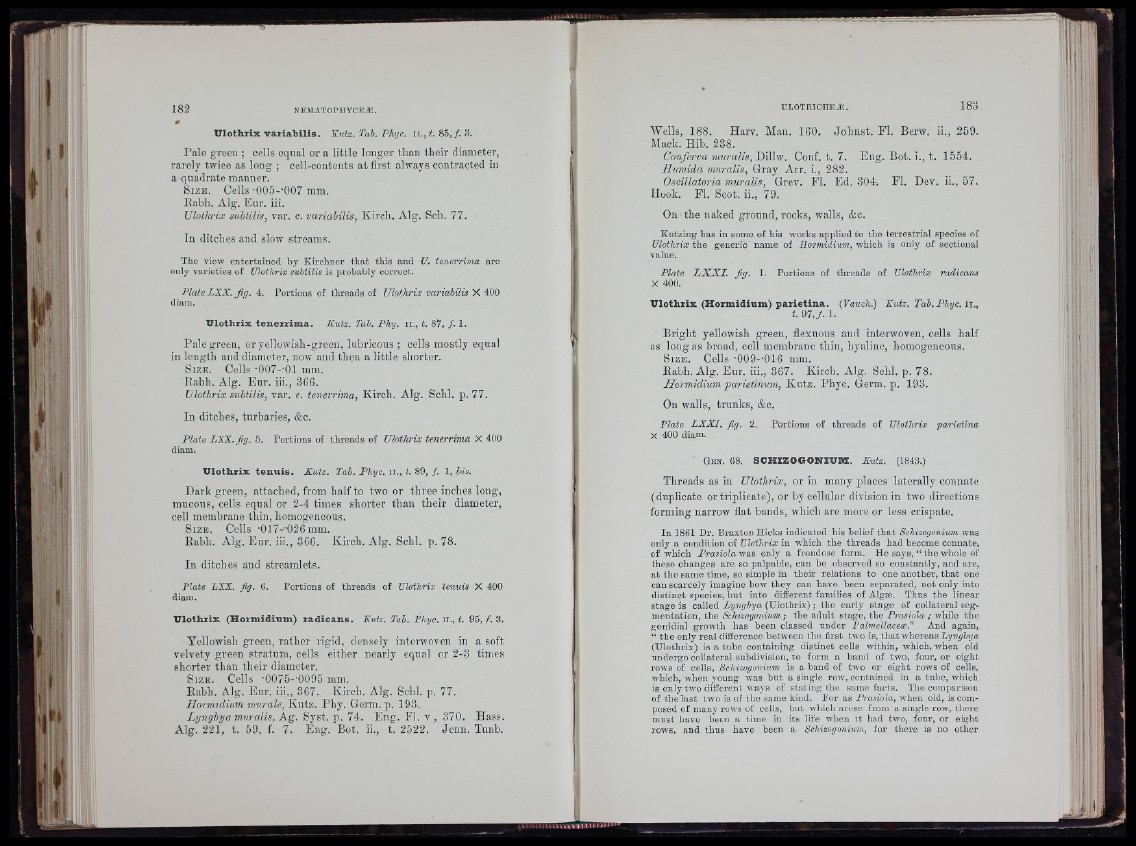
M
ir:>
ip
U lo th r ix v a r ia h ilis . Kntz. Tab. Phyc. ii., t. 85,/. 3.
Pale green ; cells equal or a little longer than their diameter,
rarely twice as long ; cell-contents at first always contracted in
a quadrate manner.
S iz e . Cells -005--007 mm.
Rabh. Alg. Eur. iii.
Ulothrix subtilis, var. c. variahilis, Kirch. Alg. Sch. 77.
In ditches and slow streams.
The view entertained by Kirchner that this and U. tenerrima are
only varieties of Ulothrix subtilis is probably correct.
Plate LXX. jig . 4. Portions of threads of Ulothrix variahilis X 400
diam.
Ulo thr ix tenerrim a. Kutz. Tab. Phy. n., t. 87, /. 1.
Pale green, or yellowish-green, lubricous ; cells mostly equal
in length and diameter, now and then a little shorter.
S iz e . Cells -007--01 mm.
Eabh. Alg. Eur. iii., 366.
Ulothrix subtilis, var. e. tenerrima, Kirch. Alg. Schl. p. 77.
In ditches, turbaries, &c.
Plate LXX. fig. 5. Portions of threads of Ulothrix tenerrima X 400
diam.
U lo th r ix t e n u is . Kntz. Tab. Phyc. ii,, t. 89, /. 1, bis.
Dark green, attached, from half to two or three inches long,
mncous, cells equal or 2-4 times shorter than their diameter,
cell membrane thin, homogeneous.
S iz e . Cells •017-'026mm.
Eabh. Alg. Eur. ill., 366. Kiroh. Alg. Schl. p. 78.
In ditches and streamlets.
Flate LXX. fig. 6. Portions of threads of Ulothrix tenuis X 400
diam.
U lo th r ix (Hormidinm) rad ican s. Kutz. Tab. Phyc. ii., t. 95, f. 3.
Yellowish green, rather rigid, densely interwoven in a soft
velvety green stratnm, cells either nearly equal or 2-8 times
shorter than their diameter.
S iz e . Cells -OOIS-'OOgS mm.
Eabh. Alg. Eur. iii., 867. Kirch. Alg. Schl. p. 77.
Hormidium murale, Kutz. Phy. Germ. p. 198.
Lyngbya muralis, A g . Syst. p. 74. Eng. Fl. v , 370. Hass.
Alg, 221, t. 59, f. 7. Eng. Bot, ii., t. 2522. Jenn. Tunb.
Wells, 188. Harv. Man. 160. Jo h n s t. Fl. Berw. ii., 259.
Mack. Hib. 238.
Conferva muralis, Dillw. Conf. t. 7. Eng. Bot. i., t. 1554.
Ilumida muralis, Gray Arr. i., 282.
Oscillatoria muralis, Grev. Fl. Ed. 304. Fl. Dev. ii., 57.
Hook. F l. Scot. ii., 79.
On the naked ground, rooks, walls, &c.
Kntzing has in some of his works applied to the terrestrial species of
Ulothrix the generic name of Bormidium, which is only of sectional
value.
Plate Z X X I . fig. 1. Portions of threads of Ulothrix radicans
X 400.
U lo th r ix (Hormidium) p a r ie tina . {Vauch.) Kutz. Tab. Phyc. Ii.,
t. 9 7 ,/. 1.
Bright yellowish green, flexuous and interwoven, cells half
as long as broad, cell membrane thin, hyaline, homogeneous.
S iz e . Cells -OOg-'Oie mm.
Eabh. Alg. Eur. iii., 367. Kirch. Alg. Schl. p. 78.
Hormidium parietinum, Kutz. Phyc. Germ. p. 193.
On walls, trunks, &o.
Plate L X X I. fig. 2. Portions of threads of Ulothrix parietina
X 400 diam.
G en . 68. SCHIZOGONIUM. Kutz. (1843.)
Threads as in Ulothrix, or in many places laterally connate
(duplicate or triplicate), or by cellular division in two directions
forming narrow flat bands, which are more or less críspate.
In 1861 Dr, Braxton Hicks indicated his belief that Schizogonium was
only a condition of Vlothriæ in which the threads had become connate,
of which Prasiola was only a frondoso form. He says, “ the whole of
these changes are so palpable, can be observed so constantly, and are,
at the same time, so simple in their relations to one another, that one
can scarcely imagine how they can have been separated, not only into
distinct speoies, but into different families of Algæ. Thus the linear
stage is called Lyngbya (Ulothrix) ; the early stage of collateral segmentation,
the iSc/irtojimMim; the adnlt stage, the Arasioía. ; while the
gonidial growth has been classed nnder Palmellaceoe.” And again,
“ the only real difference between the first two is, that whereas Lyngbya
(Ulothrix) is a tube containing distinct cells within, which, when old
undergo collateral subdivision, to form a band of two, four, or eight
rows of cells, Schizogonium is a band of two or eight rows of cells,
which, when young was but a single row, contained in a tube, which
is only two different ways of stating tho same facts. The comparison
of the last two is of the same kind. For as Prasiola, when old, is composed
of many rows of cells, but which arose from a single row, there
must have been a time in its life when it had two, fonr, or eight
rows, and thus have been a Schizogonium, for there is no other
" I
li Í
i